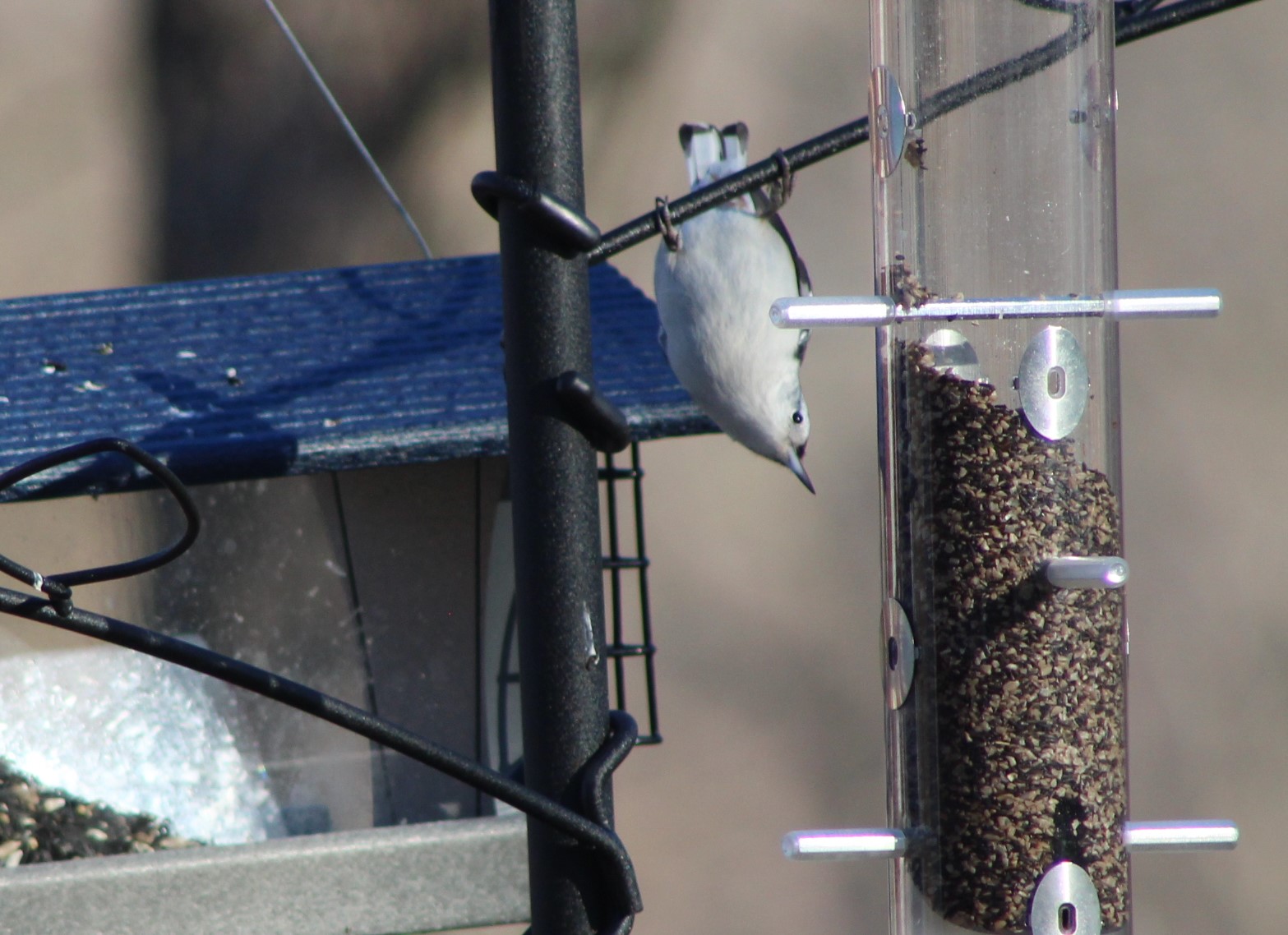Throughout the year, I’ve heard a distinctive bird call that sounds like a loud, nasal “yank” repeated several times in a row. This tells me that at least one pair of white-breasted nuthatches (Sitta carolinensis) live on Owl Acres year-round. They have mated for life, and have established a territory in the woods. We’ll hear their calls all winter as the pair defend their nesting territory.
The nuthatch gets its name from its strategy with—you guessed it—nuts. The bird will take an acorn or hickory nut to a tree, tuck it into a crevice in the bark to hold it still, and hammer at it with its strong chisel-shaped beak until the nut or seed cracks. The nuthatch will stash nuts and seeds it doesn’t need just now into loose bark or in crevices for future reference. Although 70% of its diet is seeds and nuts, the nuthatch also eats caterpillars, ants, and pest species such as pine weevils, scale insects, and jumping plant lice. She finds these morsels by creeping along branches, sometimes head first down the trunk, or up side down, searching in cracks and crevices in the bark on the underside of a branch. To help her move in all orientations, including straight down or hanging beneath the branch, she has strong, curved talons that allow her to catch hold of irregularities in the bark but don’t interfere with perching.
The white-breasted nuthatch is about the size of a sparrow, with a short tail. It averages about five inches in length with a wingspan of eight to ten inches. It weighs two thirds to three-fourths of an ounce. Its back is a grey-blue, and its face and underparts are bright white. It sports a black or gray hood on a head that seems somewhat large for its body.
The nuthatch is a tidy housekeeper. She first finds a hole in a tree, often one excavated by a woodpecker. She moves in and lines the cavity with lumps of dirt, bark and fur. Then she makes a cup out of grass, bark, feathers and other soft materials. This is where she’ll lay her five to nine eggs, which she’ll incubate for a couple of weeks while her partner brings her food. She likes to keep her nest clean, so when the eggs hatch, she carefully removes the shells. She may also sweep the entrance with a piece of animal fur or crushed insect held in her bill. This behavior is thought to defend against predators by masking the scent with the insect or animal smell.
Now baby birds, like baby humans, follow the time-honored trope of what goes in must come out, like the insects and spiders their parents feed them. The baby birds don’t wear diapers per se, but they do deposit their waste in a tidy packet called a fecal sack. This makes it easy for mama bird to clean up after them. She takes the fecal sacks out of the nest and deposits them on tree branches. This way, her nest can stay clean. Most songbirds follow this practice to one degree or another. Even when she’s not raising her young in winter, she will remove her own feces from her roosting site each morning. With an average lifespan of only two years, the nuthatch is always on the lookout for predators. Tree-climbing snakes, woodpeckers, and squirrels want to eat her eggs and young, and hawks and owls want to eat her.
The nuthatch is a family bird. She mates for life, short though it may be, and together the pair feed the chicks for about 26 days before they fledge. Even after the babies leave the nest, the parents continue to feed and protect them for several more weeks.
White-breasted nuthatches over winter on Owl Acres. When times get tough and food is hard to find, they will join with woodpeckers, titmice, chickadees and other small birds to create mixed flocks hunting for food. By joining the mixed flocks, they can alert each other to discoveries of food caches, and they can also share sentinel duties, watching out for hawks, owls and other predators. There’s safety in numbers here, and even if an owl catches one for dinner, the chances of being that one are a lot less when the owl has to pick from 20 birds instead of one. They’ve also been seen flocking together to stay warm on brutally cold winter nights.
As a native to Owl Acres and North America in general, the white-breasted nuthatch has the tools she needs, particularly her claws and beak, to live well in her habitat. For that reason, the white-breasted nuthatch population is actually increasing because of their adaptability to edge environments like Owl Acres. This fall we’re putting sunflower seeds, peanuts and other food for them in our birdfeeder. They will eat well this winter.
Photo by Author

3 comments
They are so fun to watch at the feeders! Great blog, thank you!